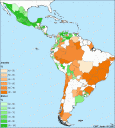A fine and detailed report on a taro diversity day held at the University of Hawaii’s field station near Molokai. The report makes clear why field genebanks need to exist, the threats to genebanks in general and taro in particular, and the vital links between culture and agriculture.
Fine beans
We just received a message from Christine, a reader in New Zealand, who hopes ultimately to do a roundup of seed-saving efforts down there for us. In the meantime, she has a question:
Yesterday I sowed Fin de Bagnol bean seeds, an heirloom French variety. As I did so I wondered what the name meant – it seemed strange to have ‘End’ in a seed name. I did a spot of googling to try and find an answer, but no luck.
Maybe you have a French contact who knows?
Indeed, maybe we do. Meantime, I think that fin in this case means “fine” or “slender” rather than “end”. There are other French beans with the same word; Deuil Fin Precoce for one, which is early (precocious).
So my guess is that this is a fine, slender bean of the Bagnols, but whether it is a Bagnol family, or the rather fine Château de Bagnols (which might be linked to the family) I cannot say. Probably the Château.
But maybe someone out there knows for sure.
Simposio de Recursos Genéticos para América Latina y el Caribe
Greetings from Mexico DF. I’m here for SIRGEALC, which is always a great opportunity to meet up with old friends working on agricultural biodiversity in the Americas, and see what they’ve been up to lately. I’ll try to blog about the highlights as the week goes on.
Maize preferences survey
 Glenn Hyman at CIAT is doing a survey of the preference for different maize colours in Latin America. There’s a questionnaire you can take. The results so far are shown on the map to the left: dark brown is a strong preference for yellow maize, dark green for white. Glenn told us about it in a comment on a post of mine a couple of days back, but I figured he’d like some more publicity.
Glenn Hyman at CIAT is doing a survey of the preference for different maize colours in Latin America. There’s a questionnaire you can take. The results so far are shown on the map to the left: dark brown is a strong preference for yellow maize, dark green for white. Glenn told us about it in a comment on a post of mine a couple of days back, but I figured he’d like some more publicity.
Planting a barrier to block UG99 wheat rust
An article in the November issue of Agricultural Research magazine, house organ of the US Department of Agriculture, warns: “World Wheat Supply Threatened!” complete with exclamation point. Well, yes, as we have indeed pointed out before. However, the article’s subtitle explains: “Luckily, research is under way to defend this grain of life.”
Phew! They had me worried.
Hidden in the write-up, which is to-the-point and interesting, is what struck me as a pretty off-the-wall suggestion. US scientists plan to focus resistant varieties (if and when they are developed) in southern states such as Texas, Georgia and Louisiana. The spores of UG99 can overwinter in the warm climates of the South, so the hope is that by preventing the disease getting a hold there, they can prevent it spreading to the rest of the country. Intriguing idea, but I wonder whether it really stands a chance.
There’s more in the article, on the resistance genes that might be inserted into US wheats and on the vital role of properly trained people in the field, who spotted UG99 early on and were able to sound the alarm.